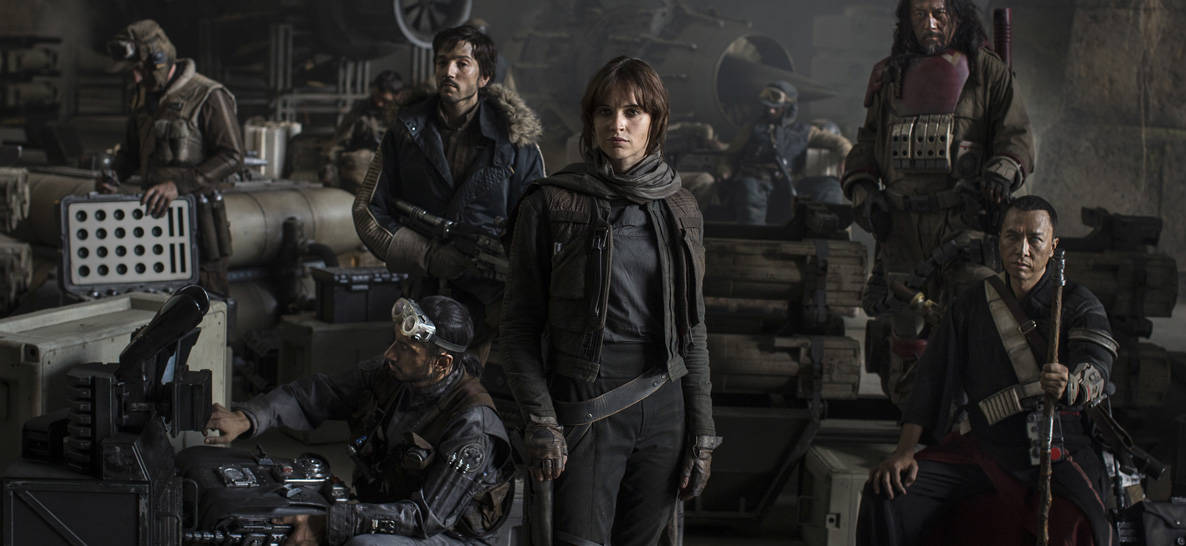
In the second half of Rogue One: A Star Wars Story, one of the characters makes what almost feels like a war-crime confession: “We’ve all done terrible things for the rebellion,” he grieves.
Alongside him stands a group of Republic soldiers, assassins and killers, each looking for a reason to say their scars and sins were worth it. If the producers were to rename Rogue One based on this scene alone, they could do worse than “PTSD in Space.”
In the first of what will likely be numerous stand-alone Star Wars films, the rebel leaders are anything but ideal. They’re thieves, religious extremists and murderers. They don’t blink at killing unarmed civilians or unspooling a prisoner’s mind with the equivalent of slug waterboarding.
But perhaps this quality is what makes Rogue One unique among the other films in the franchise. You know all those space battles you staged with stormtrooper action figures? Those campaigns waged in Battlefront? Rogue One looks at the morality behind these conflicts, and in a way, reminds us of what the Star Wars franchise is really all about—a war.
Set shortly before the events in Episode IV: A New Hope, Rogue One tosses audiences into the middle of a decades-spanning conflict between the oppressive Empire and the freedom-longing Republic. When word gets out that the Imperial army’s been toiling away at a “planet killer” weapon, the rebels recruit a lawless nomad named Jyn Erso (Felicity Jones), and a Republic intelligence officer, Cassian Andor (Diego Luna), to track down a supposed defector who may hold the key to the resistance’s survival.
While I won’t go into much more plot detail—most fans prefer to be surprised—it’s no spoiler to say the rebels’ journey comes to a head when Jyn and her team stage a battle to steal the Death Star blueprints from the Empire (a plotline referenced in the opening crawl of A New Hope). Fans will either be thrilled or annoyed by all the consequential callbacks to previous installments—and one pretty bad CGI character—but when the large-scale confrontation finally hits, one can’t help but admit it’s fun to watch the pieces snap together.
And that’s partially why Rogue One is also a bit disappointing. While the narrative builds an interesting set of characters around Jyn for a sturdy third act, Rogue One can’t seem to catch its breath in the film’s first section, and chases its own tail in the second. Two characters in particular—Donnie Yen, who plays a blind, monk-like devotee of the Force, and a consistently humorous droid named K-250 (voiced by Alan Tudyk)—standout here.
But the rest of the cast, including Forest Whitaker, Mads Mikkelsen, and Wen Jiang, often feel less like living, breathing individuals, and more like excuses to achieve a type of Ocean’s Eleven or Magnificent Seven diversity. When the big payoff finally comes, we feel emotion and exhilaration, but we’re not moved.
What director Gareth Edwards (Monsters, Godzilla) lacks in a cohesive, affecting story though, he partially recoups in humanizing the lumbering mechanisms of conflict. Several battleshots feel less like space-opera finesse, and more like edited images from World War II or Vietnam, with Stormtroopers and laser cannons replacing steel artillery and camouflage fatigues. When Jyn and Cassian arrive on a desert moon named Jedha, one might think Edwards has transported us to the dusty streets of Kabul or Baghdad.
Soon after, as an Imperial tank machine attempts to squash the indigenous resistance, Edwards edits the sequence to highlight just how out of place the bleached Stormtroopers are among the dark, primitive wardrobe of the city’s citizens. The Empire uses the excuse of political stability to defend their occupation—we soon find they’ve invested in a mining operation.
At one point, an explosion erupts from the populated city. As flames engulf the sky, the camera cuts above the moon’s atmosphere, slowly panning toward the hovering Death Star. It’s one of the more poetic images of the franchise, and simultaneously communicates both awe and terror. In a world that is no stranger to nuclear weapons, it reminds us of the devastating power we possess to level entire cities with the click of a few buttons. We saw planets explode in previous Star Wars films, but somehow this feels different.
Much has been made the last few decades regarding religion and the Star Wars universe, and it’s not much of a stretch to see the spiritual, even Christian, parallels in Rogue One—especially regarding the connection between hope and faith. Edwards’ film is at its best, however, when it attempts to question its own on-screen violence. There’s no doubt the story lands on the side of freedom and personal bravery, but in a surprising way, Rogue One manages to find little gray between both light and dark sides. Is all truly fair in war?
For a contemporary society now facing numerous conflicts at home and abroad, Rogue One might hold as much subtext regarding our current affairs as A New Hope did for Vietnam.
While there are no Jedi in Rogue One, the universe’s life-sustaining Force folds like smoke around the edges of the screen. In fact, religion is one of the Empire’s main targets on their march toward domination. During one scene, we hear of the Empire leveling the temple of a mysterious group dubbed, “The Guardians of the Wills.” One holy city, akin to the real-life carved desert cliffs of Petra, crumbles before our eyes. As one character prays near the middle of the film, he’s questioned for his devotion. The Empire has not only broken their spirit, but broken their faith.
Ben Mendelsohn plays the film’s main antagonist, an Imperial officer named Orson Krennic, with leveling coolness, save for the scenes when his reputation with Darth Vader or the Emperor lies in jeopardy. He’s a pure bureaucrat who sees soldiers and citizens as tiny figurines in a universe-spanning chess set. In contrast, Vader first appears in a cloud of smoke like a red-eyed demon, communicates both fear and power. In war, it’s not just physical will that wins the day, but forces of mind and spirit.
In dropping “adventure” from the “action and adventure” genre, Edwards isn’t afraid to make the struggle for freedom a complicated war of attrition. The rebel army functions in a I Corinthians 12 sort of way—“the body is not made up of one part but of many.” Jyn may represent the brain or heart, but another soldier is a limb. Still another a vein or toe.
Yet, this unity is not without cost. And maybe, despite the film’s tendency to fall back into action blockbuster tropes, this boldness could represent a new direction for the franchise. Not everyone ends up dancing on the forest moon of Endor with Luke Skywalker, or is rescued at the last minute from the Starkiller Base like Rey in The Force Awakens. Sometimes, the individual, ordinary soldiers are just good enough to do their job, and the mission is only a success because when they fall, someone else takes their place.
In a world that often glamorizes war, maybe a flawed, overly nostalgic Star Wars film might have a thing or two to teach us about what it means to fight.





















